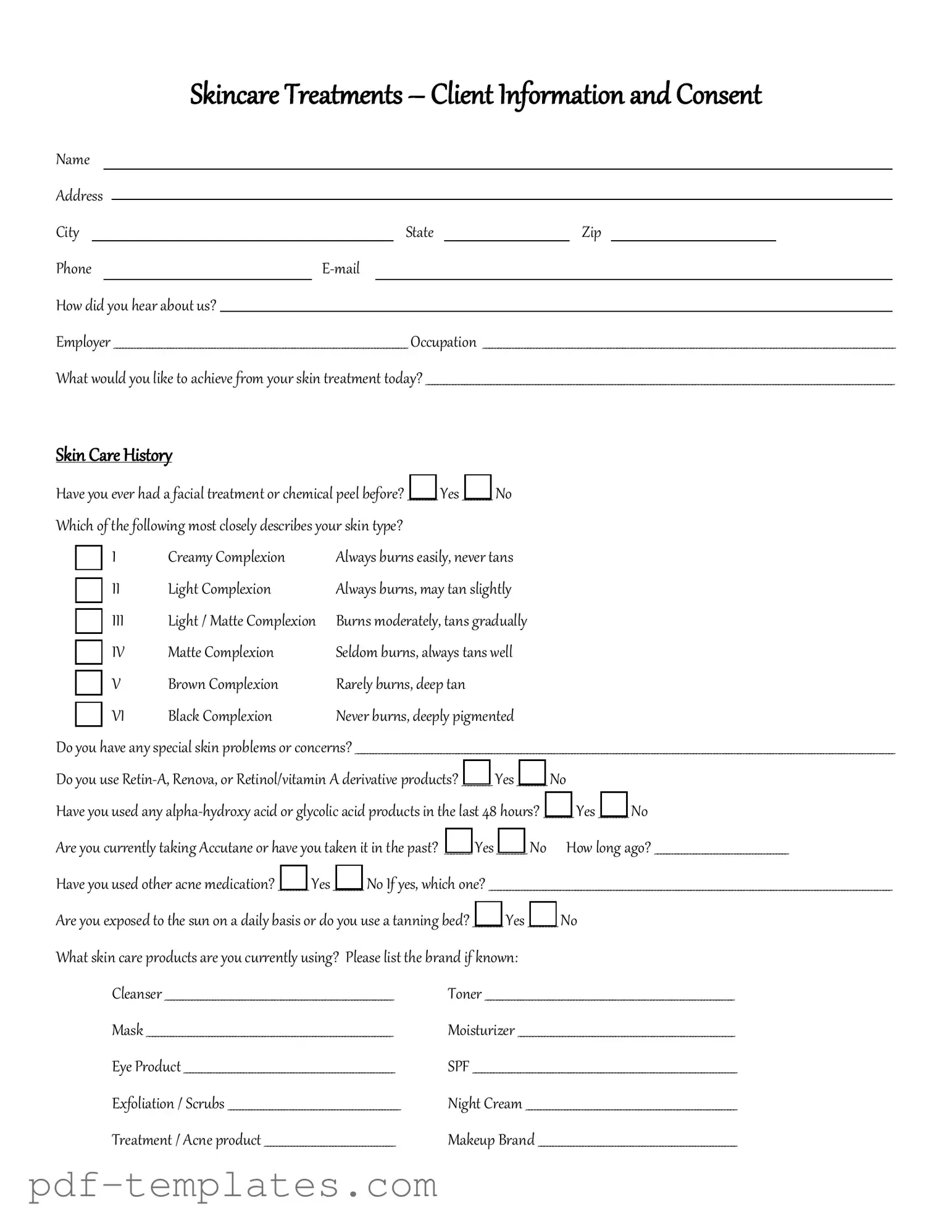The Facial Consent form is similar to the Medical Consent form, which is used in various healthcare settings. Like the Facial Consent form, the Medical Consent form ensures that patients understand the risks and benefits of a medical procedure or treatment. Both forms require clear communication between the provider and the patient, emphasizing the importance of informed consent. Additionally, both documents often include sections for patients to ask questions and express their understanding before proceeding.
Another document that shares similarities with the Facial Consent form is the Informed Consent for Surgery form. This form is specifically tailored for surgical procedures, detailing the specific risks, benefits, and alternatives related to surgery. Just as the Facial Consent form outlines the specific treatments and procedures for facial treatments, the surgical form provides comprehensive information to help patients make educated decisions regarding their health.
The Cosmetic Procedure Consent form is also akin to the Facial Consent form. This document is used in the context of cosmetic treatments, such as Botox or fillers. Both forms outline the nature of the procedure, potential side effects, and the expected outcomes. They serve to ensure that patients are fully aware of what the procedure entails, thereby fostering trust between the practitioner and the patient.
The Release of Liability form is another document that resembles the Facial Consent form. While the Facial Consent form focuses on obtaining permission for treatment, the Release of Liability form aims to protect the provider from legal claims related to the procedure. Both documents require a patient’s signature, indicating their understanding and acceptance of the associated risks.
The Treatment Consent form is similar in function to the Facial Consent form, as it is used for a wide range of medical and therapeutic treatments. Like the Facial Consent form, it outlines the treatment process, potential risks, and expected benefits. The Treatment Consent form ensures that patients have a clear understanding of what to expect, thus promoting informed decision-making.
The Psychological Services Consent form also parallels the Facial Consent form. This document is utilized in mental health settings and outlines the nature of the psychological services provided. Both forms emphasize the importance of informed consent, ensuring that individuals are aware of the treatment process and any potential risks involved.
The California Motor Vehicle Power of Attorney form is essential for individuals seeking to appoint an agent to manage specific vehicle-related tasks in their absence. This legal document ensures that matters such as vehicle registration and sales can be handled efficiently by a trusted individual. For those needing assistance with such responsibilities in California, it is vital to understand the importance of this form. You can find more information about this and other relevant documents at All California Forms.
The Anesthesia Consent form shares similarities with the Facial Consent form as well. This form is specifically designed for procedures that involve anesthesia. Just like the Facial Consent form, it provides detailed information about the procedure, the type of anesthesia used, and potential risks. Both forms serve to protect patients by ensuring they are well-informed before undergoing any medical intervention.
The Research Consent form is another document that bears resemblance to the Facial Consent form. This form is used when individuals participate in clinical trials or research studies. Both forms require clear explanations of what participants can expect, including risks and benefits. They emphasize the importance of voluntary participation and the right to withdraw at any time.
The Minor Consent form is similar to the Facial Consent form in that it is used when obtaining consent for individuals under the age of 18. Like the Facial Consent form, it requires a parent or guardian's signature, ensuring that minors receive appropriate care while also protecting their rights. Both forms aim to educate and inform, allowing guardians to make decisions in the best interest of the minor.
Lastly, the Telehealth Consent form is akin to the Facial Consent form, particularly in the context of remote consultations. As telehealth becomes increasingly popular, this form outlines the specifics of receiving care through virtual means. Similar to the Facial Consent form, it addresses confidentiality, potential risks, and the nature of the services provided, ensuring that patients are informed and comfortable with the telehealth process.
